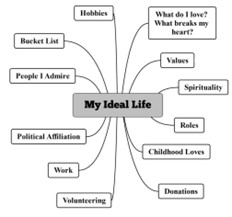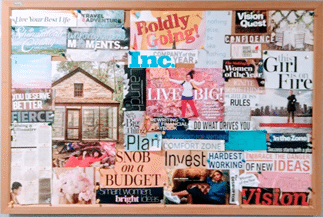The Activist for Activists. Author of Make a Difference with Mental Health Activism and The Happy Activist: Journey the 5-Step Activism Path to Focus Your Passion and Change the World. Teacher, Psychologist, Environmental Activist, Animal Lover.
- The Meaning of Critical Thinking: A Key Skill for Navigating Today’s Information Landscape - November 3, 2025
- Grandparents Can Develop Activist Grandchildren - September 29, 2025
- Top Six Reasons Credit Union Benefits Are a Smart Choice Over Banks - August 18, 2025
Imagine living your ideal life, one that provides you with purpose and passion. Make it happen! The best tools for this are visioning and visualization.
Creating your ideal life helps you live intentionally, including how you want to make a difference in the world. With a clear focus on your purpose, you can align your energy, increase your resilience, and make deeper, lasting contributions to your community and cause.
What are Visioning and Visualization?
Visioning is a creative method of imagining your ideal life or world. Visioning taps into your deep desires for your life. For example, visioning might involve journaling about what “a day in my ideal life” looks like or meditating to meet your “future self.”
Visualization means using your imagination to mentally rehearse your ideal life. Visualizing helps you clarify your goals. With clear goals, you will experience more motivation and better performance. When you visualize, you imagine your future life with attention to sensory detail.
Visioning focuses on your desired future life (the “what”), and visualization focuses on creating mental images of you achieving that life (the “how”).
Visioning and visualization help you step beyond your current life and focus on what you truly want.
Visioning and Visualization Techniques to Explore
Visioning Techniques
Visioning helps you define your ideal life or a long-term goal.
Brainstorming
Brainstorming is a way of generating ideas without making judgments about them. What does your joyful, ideal life look like? Be creative and make sure to think outside the box. When you brainstorm, you list ideas until you cannot think of any more. Only then do you evaluate the ideas to find the best ones to pursue.
Mind Mapping
Use a mind map to visually organize thoughts and ideas related to the vision. Start with a central topic and branch into subtopics, exploring various aspects of an ideal life. You can draw your mind map by hand or use mind mapping software.

Vision Boards
A vision board is a collage of images, words, and pictures that reflect your goals and dreams. This can be a powerful reminder of your ideal life vision to keep you focused and motivated.
Lucia Capacchione’s book Visioning is an excellent resource for more creative, right-brained visioning methods.
Check out a vision board example:

Visualization Techniques
Visualization differs from visioning in that you create mental images of achieving your desired outcome.
There’s no one right way to visualize. Choose what suits you best. The goal is to free your mind and spark inspiration. You can use many techniques to visualize:
Guided Visualization
Guided meditations lead you through a visualization process. This can be especially helpful for beginners or when visualizing specific outcomes.
Sensory Engagement
Engage all five senses in the visualization, imagining the sights, sounds, smells, tastes, and tactile sensations associated with achieving your desired outcome.

How to Create a Vision of Your Joyful Life
Now that you’ve learned more about the power of visioning and visualization and explored the techniques, it is time to create a vision of your joyful life.
The overall process includes three steps.
- Step 1: Create a vision of your ideal life. Imagine your future self living your best life. Get clear about what values you are living, what roles you are playing, and what experiences you are enjoying.
- Step 2. Create a vision of your ideal and current worlds and identify the gaps. These gaps are potential areas for your activism.
- Step 3. Be clear about your passions for making a difference.
Step 1: Create a Vision of Your Ideal Life
Your ideal life is your personal north star. To build this vision:
- Imagine Your Future: Picture yourself 5, 10, or 15 years from now.
- Reflect on Key Areas:
- Roles: Which life roles (parent, professional, activist, artist, etc.) matter most to you? You can only truly excel in a few.
- Experiences: What do you want to do, see, or accomplish in your lifetime?
- Values: Which values will you be living out every day?
- Lessons from the Past: What have your successes, failures, and surprises taught you?
Now, record your visualization. Where are you? What are you doing? Who’s with you? How do you feel?
Ideal Life Vision Example:
“It’s 2035. I wake up in a cozy eco-home with a view of the mountains. I spend my days mentoring young activists, writing, and hiking with my dog. My work aligns with my values and fuels my joy.”
Step 2: Visualize Your Ideal World and Current World
Your Ideal World
Once you’ve imagined your ideal life, zoom out. What does your ideal world look like? Visualizing a better world helps you connect your joy with a cause that matters.
In your ideal world, how do people relate to one another? Is there world peace? What does the government oversee? Are Earth’s ecosystems protected? Are there borders? How do people of different religions live together? How do we nurture our children?
Your Current World
Now, return to the present. What does your world currently look like?
Compare your Ideal and Current Worlds
Where are the gaps between your current world and your ideal one? Reflect on:
- What would need to change—in your life and in the world—to close that gap?
- Who and what do you love and want to protect?
- What problems would you love to solve?
- What issues break your heart?
This reflection helps identify areas where your vision can lead to action.
Step 3: Examine the Gaps and Identify Your Passions
Once you’ve visualized your joyful life and your ideal world, you’re ready to explore where the two meet. This is the first step toward making a difference with effectiveness and motivation.
Ask yourself:
- What cause aligns with my deepest values and vision?
- What problem do I feel most motivated to solve?
- Where do my skills, interests, and energy best fit?
Focusing on your passions is the first step in changing the world. What is the right match of your passions and skills with the needs of the world?
Example
“I will co-lead a local initiative to help youth fight climate anxiety through art and storytelling. We will host regular workshops and partner with local schools.”
The Rest of Your Activism Path

Visioning and visualization are also important in other steps in the Activism Path. Use it throughout your journey:
Craft Your Ideal Opportunity: Picture your dream role. What kind of volunteering or advocacy lights you up?
Solo vs. Group Action: Imagine the pros and cons of working alone vs. joining a team or movement.
Creating a vision for your joyful life isn’t just an exercise. You can make it the roadmap for your ideal life and a foundation for meaningful action.
Begin with vision. Return to it often. Let it evolve as you do.
READ NEXT
Learn more about Getting Started in Activism.
- Focus your passion and find the cause closest to your heart among the myriad of causes.
- Match your skills with the type of activism work that best suits you.
- Find an activism opportunity that works for your life.
- Determine if your social justice work truly makes an impact.
- Stay motivated in your activism for the long term.
The 5-Step Activism Path Workbook contains surveys, checklists, and reflections designed to help you envision your ideal life.



